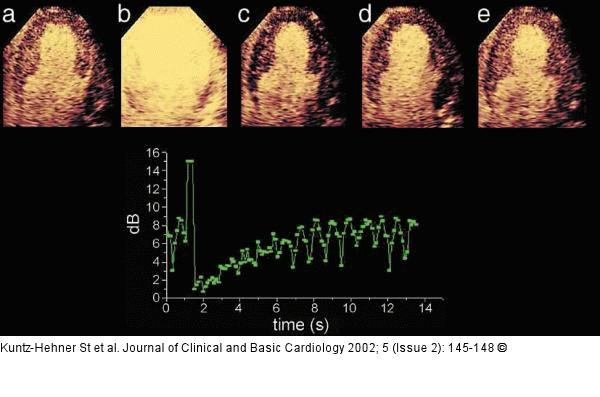Kuntz-Hehner St, Becher H, Luederitz B, Omran H, Schlosser Th, Tiemann K Assessment of Myocardial Perfusion by Contrast Echocardiography - Ready for Clinical Practice? Journal of Clinical and Basic Cardiology 2002; 5 (2): 145-148 PDF Summary Overview
| ||||
Figure/Graphic 2a-e: Kontrastechokardiographie Negative bolus destruction reperfusion study using power pulse inversion imaging. First, continuous infusion of a contrast agent is adjusted to achieve full myocardial opacification using real-time imaging at very low emission power (a) (MI = 0.09). After destruction of the microbubbles by a short period of high power imaging (b) (MI = 1.3) myocardial contrast replenishment is recorded at low emission power (c–e) (MI = 0.09). A region of interest (ROI) is placed in the septum and repeated measurements are made at the endsystolic frames. The graph shows the reperfusion curve for this ROI, fitting well to the monoexponential function. |

Figure/Graphic 2a-e: Kontrastechokardiographie
Negative bolus destruction reperfusion study using power pulse inversion imaging. First, continuous infusion of a contrast agent is adjusted to achieve full myocardial opacification using real-time imaging at very low emission power (a) (MI = 0.09). After destruction of the microbubbles by a short period of high power imaging (b) (MI = 1.3) myocardial contrast replenishment is recorded at low emission power (c–e) (MI = 0.09). A region of interest (ROI) is placed in the septum and repeated measurements are made at the endsystolic frames. The graph shows the reperfusion curve for this ROI, fitting well to the monoexponential function. |


